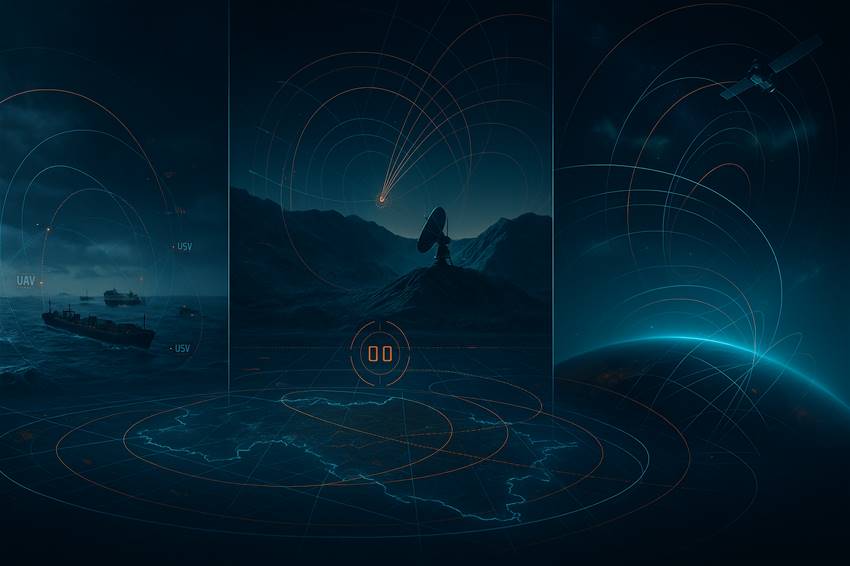
Instinct will not stop a combined attack or restore GNSS when signals vanish at the worst moment. Recent years offer proof. A G5 solar storm in May 2024 degraded GPS and HF. Red Sea lanes filled with drones, explosive USVs, and anti-ship missiles, with cascading effects on shipping, insurance, and delivery times. GNSS spoofing and jamming forced civil aviation to re-activate contingency procedures. In low Earth orbit, debris dynamics turned conjunction risk into a daily variable. This context does not forgive trial and error. You need evaluations that are precise, fast, and frugal, in this order. Serious modeling and simulation deliver exactly that.
Replace siloed tools with a mission-level digital twin. You hold platform, sensors, links, environment, and time in one frame. This is systems engineering, not marketing. RF propagation over complex terrain and sea surfaces. Six-DoF kinematics. EO and IR chains with realistic atmosphere. Sensor planning and tasking. Data networks with modeled latency and path loss. Telemetry re-ingested to update estimates and covariances. Decisions follow verifiable metrics under uncertainty with traceable assumptions.
At sea, you route convoys in the presence of non-linear threats, including UAV and USV, anti-ship missiles, and electronic warfare. You study rules of engagement and firing geometry while closing the sensor-to-shooter loop. You assess C2 resilience under contested conditions or degraded GNSS. Simulation accounts for tropospheric ducting and specular reflections. You measure probability of detection and tracking over time, compare alternatives, and stress plans with Monte Carlo and what-if scenarios. Value is not animation. Value is early identification of the weak link under saturation and denial. When a route crosses Bab el-Mandeb, security, time, and cost trade-offs become an industrial survival question.
On land and in the air, the Ukrainian lesson is clear, no pure threats. UAS swarms, persistent ISR, mixed salvos of cruise, ballistic, and hypersonic vectors, electronic warfare, deception. Mission-level modeling lets you design hybrid C-UAS and GBAD architectures, allocate sensors to engagement corridors, and quantify operator workload. Above all, you compress the OODA loop. You do not guess battery placement or fire-authorization timing. You select a configuration that maximizes probability of intercept under constraints on munitions, logistics, and electronic fratricide. You verify robustness when the adversary changes tempo.
In orbit, stakes double. Every maneuver spends propellant. Every error damages reputation and downstream services. A tight pipeline links orbit determination, multi-sensor fusion, and conjunction assessment. Use realistic measurement models, radar, optical, IR, TDOA, FDOA. Generate estimates with credible covariances. Apply gating consistent with uncertainty. Compute Pc. Drive maneuver or no-maneuver decisions by risk and window of opportunity. Risk extends beyond debris. Solar-activity peaks during 2024 and 2025 changed atmospheric density and decay rates. A growing catalog and crowded operational orbits demand air-traffic-control discipline in LEO. Without an end-to-end modeled chain, you fly visually, and in LEO this is a bad idea.
Civil domains face tough constraints as well. Managing critical networks requires coverage and interference design before first power-on. Civil protection must plan ISR and remote-sensing missions for fires, floods, and landslides with orbital constraints, cloud cover, look angles, and revisit times. Energy-infrastructure operators must treat G4 or G5 alerts as operational drivers which degrade positioning and HF, and in some cases introduce systematic errors into workflows. The thread stays constant, bring operational variables into the model and use the model to choose.
Method matters. Physics-based models alone do not suffice without uncertainty governance. Compute estimates with traceable covariances. Run Monte Carlo with adequate sample size. Apply design of experiments to sweep the parameter space. Build surrogates for speed without leaving the domain of validity. Close loops with data assimilation. Automate the workflow to remove repetitive manual steps. Live, Virtual, Constructive is not a buzzword. LVC validates tactics and trains operators inside scenarios governed by the same physics as real theaters. When an assumption changes, regenerate the full chain with versioning and traceability. Otherwise this is stagecraft, not engineering.
Precise, fast, frugal is not a slogan. This is a consequence. In a tense environment with scarce time and finite money, you protect people and assets at sea, on land, and in space by reducing complexity to measurable decisions before deadlines close. Treat modeling and simulation as infrastructure, not as a special effect. Everything else is trial and error, useful for debriefs, not for winning the next operational window.





